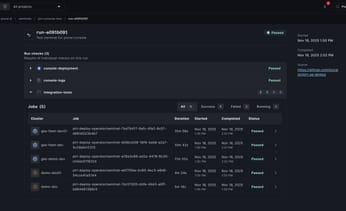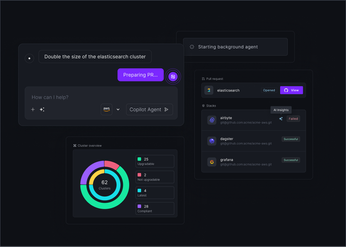
5 Self-Hosted Argo CD Alternatives for Platform Teams
Explore five self-hosted Argo CD alternatives that enhance continuous delivery with better security, scalability, and integration for platform teams.
The “free” license of open-source tools like Argo CD often obscures their real cost: engineering time. Platform teams frequently spend significant hours setting up, upgrading, maintaining, and debugging Argo CD—especially when sync issues arise at critical moments.
As environments grow more complex, the need to add additional tools for security scanning, policy enforcement, and progressive delivery increases operational overhead. This mounting complexity drives many teams to explore alternatives that provide a more integrated, predictable platform experience.
In this article, we’ll unpack the hidden costs of self-hosting Argo CD at scale and explore five alternatives built to minimize operational burden and maximize developer velocity.
Unified Cloud Orchestration for Kubernetes
Manage Kubernetes at scale through a single, enterprise-ready platform.
Key takeaways:
- Recognize when you've outgrown single-purpose tools: Argo CD is a strong starting point for GitOps, but scaling often exposes gaps in security, progressive delivery, and resource management. The need for an alternative arises when managing a fragmented collection of tools becomes a significant operational burden.
- Evaluate alternatives on their ability to unify workflows: The best solutions integrate application deployment with Infrastructure as Code (IaC) management. Look for a platform that provides a single control plane for your entire Kubernetes fleet, simplifying multi-cloud operations and reducing toolchain complexity.
- Calculate the total cost of ownership, not just the license fee: Open-source tools carry hidden costs in engineering hours spent on maintenance, integration, and troubleshooting. An enterprise platform like Plural can lower this TCO by offloading operational tasks and providing a streamlined, supported experience.
Why Look for an Argo CD Alternative?
Argo CD is a powerful tool for implementing GitOps in Kubernetes. It offers a declarative, auditable deployment model by syncing application state from Git, making it a popular choice for teams adopting continuous delivery. However, while Argo CD works well for small-scale environments, it can become a limiting factor as organizations scale.
The challenge isn't that Argo CD is inadequate—it's that it may not be the right fit for evolving requirements. What starts as a lightweight solution for a single team can become an operational burden when expanded to support dozens of teams, clusters, and applications. Managing Argo CD at scale often requires significant engineering effort for upgrades, troubleshooting, and visibility across a growing deployment surface.
Cost is another key consideration. Though open source, Argo CD incurs infrastructure and maintenance costs when used at enterprise scale. Running controllers across multiple clusters, storing large application manifests, and supporting multi-tenant use cases can quickly add up. Moreover, as teams mature, they often encounter functional gaps, such as limited native support for progressive delivery, security policies, or cost tracking linked to deployments.
Ultimately, the search for an alternative is driven by shifting priorities: reduced maintenance overhead, deeper integrations, stronger governance, or a better developer experience. The right solution depends on which of these challenges matters most to your platform team.
Where Argo CD Falls Short
Argo CD played a key role in popularizing GitOps, but its architecture reveals several limitations when applied to large-scale Kubernetes environments. As platform teams manage growing fleets of clusters and applications, Argo CD’s gaps in functionality, efficiency, and usability become more pronounced. Its reliance on external tools for critical features, resource-heavy operation, and steep learning curve can all undermine efforts to deliver a secure, unified, and streamlined platform experience.
Progressive Delivery Is Fragmented
Progressive delivery strategies—such as canary releases and blue-green deployments—are essential for reducing deployment risk in modern environments. While Argo CD is often associated with these practices, it doesn’t support them natively. Instead, teams must rely on Argo Rollouts or third-party tools like Flagger to manage rollout logic. This fragmentation adds complexity: installing and maintaining additional controllers increases operational overhead and creates disconnects in your continuous delivery pipeline. Without a single control plane, teams face greater difficulty debugging issues or enforcing a unified workflow.
Security and Compliance Gaps
Security is foundational in enterprise environments, yet Argo CD lacks native support for critical functions like vulnerability scanning or policy enforcement. Securing the software supply chain requires integrating third-party tools—e.g., image scanners or policy engines like OPA Gatekeeper—into your CI/CD pipeline. These bolt-on solutions introduce inconsistency and increase the risk that vulnerabilities or misconfigurations go unnoticed. Without an integrated view, enforcing organization-wide security standards becomes an uphill battle.
No Native SLO-Based Rollbacks
Argo CD’s rollback capabilities are limited to predefined health checks and do not support automated rollbacks based on Service Level Objectives (SLOs) such as latency, error rate, or availability. If a deployment degrades service performance—even while passing health probes—Argo CD won’t automatically revert. To enable SLO-aware rollbacks, teams must manually build integrations with monitoring systems like Prometheus, Datadog, or New Relic, increasing complexity and leaving critical reliability safeguards up to custom solutions.
High Resource Usage
Despite being a control plane tool, Argo CD’s resource footprint is often substantial. Its application controllers can consume considerable CPU and memory, particularly in large, multi-cluster setups. This not only drives up infrastructure costs but can also strain shared environments, where control plane components compete with workloads for resources. For teams focused on cloud efficiency, Argo CD’s overhead is a key drawback that makes it harder to scale GitOps without also scaling costs.
A Steep Learning Curve
Argo CD’s architecture, which is built around complex CRDs like Application and AppProject, layered sync strategies, and nuanced permission models can be difficult for new users to adopt. The steep learning curve creates knowledge silos, where only a subset of the team can effectively manage or troubleshoot the system. This slows onboarding, limits developer self-service, and burdens platform engineers with maintenance responsibilities that could otherwise be distributed across teams.
Five Self-Hosted Alternatives to Argo CD
If Argo CD's tradeoffs are becoming a drag on your platform team, you're not alone. These five self-hosted alternatives offer compelling features—some with better progressive delivery support, others with a more holistic take on CI/CD and platform management.
1. Flux
Best for: Teams that want modular, extensible GitOps workflows.
Flux is a CNCF-graduated project designed as a composable set of GitOps controllers. It enables pull-based continuous delivery and supports progressive delivery via Flagger. Its modular design allows you to adopt only what you need—ideal for building a lean, customized platform.
Highlights:
- CNCF-graduated with strong community backing
- GitOps-first with native Helm and Kustomize support
- Works well with Flagger for canary deployments
- Lightweight and highly extensible
2. Jenkins X
Best for: Teams looking for CI/CD in one Kubernetes-native tool.
Jenkins X automates CI/CD pipelines using Tekton and GitOps. It goes beyond deployment, providing preview environments for pull requests and automating promotions between environments. It’s a strong choice for teams who want an opinionated but flexible CI/CD platform on Kubernetes.
Highlights:
- Integrated CI/CD pipelines via Tekton
- GitOps-based environment promotion
- Preview environments for each PR
- Less fragmented than Argo CD + Rollouts + scanner setups
3. Spinnaker
Best for: Enterprises managing multi-cloud deployments.
Spinnaker was built by Netflix for multi-cloud CD at scale. While it’s not a GitOps-native tool by default, it can be configured that way. Its real power lies in its sophisticated pipeline orchestration and robust support for progressive deployment strategies across cloud providers.
Highlights:
- Rich deployment strategies: canary, blue-green, rolling
- Multi-cloud support (AWS, GCP, Azure)
- Enterprise-grade pipeline management
- Best for high-scale, regulated orgs
4. Devtron
Best for: Teams seeking a batteries-included platform.
Devtron combines CI/CD, GitOps, security scanning, and observability into one open-source dashboard. It’s ideal for teams that want an integrated experience and want to avoid cobbling together separate tools for security, delivery, and visibility.
Highlights:
- Native support for vulnerability scanning
- Built-in progressive delivery
- Single pane of glass for CI/CD + GitOps + metrics
- Easier to onboard and scale than fragmented stacks
5. Plural
Best for: Platform teams managing fleets of Kubernetes clusters.
Plural provides GitOps-based CD as part of a larger platform focused on fleet management. Its secure, agent-based architecture supports clusters across clouds and on-premises. It also integrates tightly with Terraform and includes a self-service model for developers, helping teams manage both apps and infrastructure through PR workflows.
Highlights:
- GitOps-powered deployment plus Terraform automation
- Secure agent-based cluster management
- Developer self-service via GitHub PRs
- Unified control plane for multi-cloud K8s operations
How the Alternatives Compare
Choosing a continuous delivery (CD) tool means weighing trade-offs in performance, usability, and integration. Argo CD popularized GitOps by syncing Kubernetes clusters with Git repositories, but other tools bring different strengths, whether it’s multi-cloud support, progressive delivery, or built-in security. Here’s how top alternatives compare in the areas that matter most to platform teams.
Core Features
Argo CD focuses on syncing app state from Git to Kubernetes. Flux follows the same GitOps model, with fewer moving parts and deep Kubernetes-native integration. Spinnaker takes a broader approach, targeting multi-environment deployments across Kubernetes, VMs, and public cloud platforms.
Plural goes beyond syncing by combining continuous delivery with Infrastructure as Code (IaC), Terraform automation, and a built-in Kubernetes UI. This unified approach reduces the need for managing separate tools for deployments, dashboards, and IaC workflows.
Multi-Cloud and Hybrid Environments
Managing clusters across clouds introduces real complexity—networking, security, and observability all become harder. Spinnaker supports multi-cloud out of the box, but it often requires direct networking between your control plane and target clusters.
Plural avoids this by using agent-based delivery, where a lightweight agent runs in each cluster and pulls updates via outbound connections. This model eliminates the need for VPNs or firewall tweaks, making it easier to manage deployments in hybrid or edge environments.
Deployment Strategies
Basic GitOps syncing isn’t always enough. Real-world deployments often need safer rollout strategies like canary, blue-green, or progressive delivery.
Flux can handle some of this via Flagger, but the setup can be complex. Jenkins X builds deployment strategies into its CI/CD pipelines, while Plural lets you bring your own tools and strategies while handling sync, IaC, and environments in a single workflow.
Security and Compliance
Security is often bolted onto CD workflows as an afterthought. Argo CD supports RBAC and SSO, but hardening it typically involves integrating external tools.
Harness CD offers tighter built-in support for secret management and verification pipelines. Plural handles RBAC via Kubernetes Impersonation, syncing access policies across clusters and respecting your existing identity provider. It also avoids storing cluster credentials centrally, a common concern in self-hosted platforms.
Developer Experience
A CD tool’s usability directly affects adoption. Argo CD has a solid UI but managing it across many clusters takes effort and Kubernetes fluency.
Plural focuses on developer onboarding with self-service templates and PR automation. Developers can spin up new services or infrastructure without needing deep Kubernetes or Terraform knowledge, while platform engineers retain control over standards and policy.
Community and Support
Open-source tools like Flux and Spinnaker have strong communities and active development, but support is usually community-driven.
Plural offers open-source transparency with enterprise support and maintains a curated catalog of deployable apps. You get the benefit of open ecosystems with the confidence of direct support when things go wrong.
Breaking Down the Costs
Choosing a continuous deployment tool involves more than just comparing feature lists. The total cost of ownership (TCO) can vary dramatically between solutions, and the sticker price—or lack thereof—is often just the beginning. Understanding the full financial picture requires looking at infrastructure, maintenance, and integration expenses.
Open Source vs. Enterprise
The most immediate cost consideration is the license. While open-source tools like Flux and Jenkins X are free to download, they are not free to operate. As one analysis points out, "Continuous Deployment at scale isn't free—whether you choose an open-source tool like Argo CD or an enterprise solution... costs accumulate." The "cost" of open source is paid in engineering hours spent on setup, maintenance, and troubleshooting.
Enterprise solutions, including Plural, have a direct licensing or subscription fee. This upfront cost typically includes dedicated support, regular security patches, and managed updates, which offloads significant operational burdens from your platform team. When evaluating options, compare the predictable subscription fee of an enterprise tool against the estimated salary cost of engineers required to maintain a complex open-source alternative. You can review Plural's transparent pricing to see how this model works.
Infrastructure and Scaling
Every self-hosted CD tool consumes resources. You need to provision and pay for the underlying compute, memory, and storage required to run the control plane and any agents. Initially, these costs may be minimal. However, as your organization scales—adding more applications, clusters, and deployment pipelines—the infrastructure footprint of your CD tool will grow.
A tool that automates the deployment and management of applications inherently requires more resources as the number of managed applications increases. This leads to higher cloud bills and the need for performance tuning to keep the tool itself running efficiently. These scaling costs are a direct and recurring expense that must be factored into your budget.
Maintenance and Operations
This is often the largest hidden cost of self-hosted open-source software. Your platform team becomes responsible for everything: initial installation, configuration, version upgrades, security patching, and debugging. When a deployment pipeline breaks at 3 a.m., it's your on-call engineer, not a vendor support team, who has to solve it.
These operational tasks divert your most skilled engineers from building features for your core product. The need for specialized tools to gain detailed cost intelligence highlights how significant these operational expenses can become. Platforms like Plural are designed to minimize this burden by providing a managed, single-pane-of-glass experience that handles updates and simplifies troubleshooting across your entire Kubernetes fleet.
Integration Expenses
A new CD tool doesn't operate in a vacuum. It must integrate with your existing CI systems, source control, artifact repositories, and observability stack. The cost of building and maintaining these integrations can be substantial, especially with highly flexible but complex tools.
For example, an open-source platform like Spinnaker provides a solution for application management but often requires significant engineering effort to connect with other systems. Each integration point is another piece of custom code that your team must write, test, and maintain. This "glue code" adds to the technical debt and overall complexity of your software delivery platform, increasing the long-term TCO.
Best Practices for Making the Switch
Migrating your continuous delivery system is a significant engineering effort that impacts developer velocity and production stability. A successful transition from Argo CD to an alternative requires more than just a technical evaluation; it demands a strategic approach that considers your organization's current needs, future growth, and existing workflows. Following a structured process ensures you select a tool that not only resolves current pain points but also serves as a durable foundation for your platform engineering goals. By carefully assessing your requirements and planning the migration, you can minimize disruption and maximize the return on your investment.
Assess Your Organization's Needs
Before evaluating alternatives, you must first define what your organization requires from a CD platform. Key considerations include your deployment frequency, application complexity, security and compliance mandates, and the structure of your engineering teams. It’s also critical to analyze the total cost of ownership. As one analysis notes, "Continuous Deployment at scale isn't free—whether you choose an open-source tool like Argo CD or an enterprise solution... costs accumulate." This includes not just licensing fees but also the operational overhead of maintenance, infrastructure consumption, and the engineering time required to manage the system. A clear understanding of these needs will help you create a scorecard to measure each alternative against your specific use case.
Plan for Future Scale
The right CD tool should not only solve today's problems but also support your organization's growth for years to come. Consider your roadmap: will you be expanding to new cloud providers, adopting a hybrid-cloud model, or significantly increasing the number of services and clusters you manage? A solution that works for a dozen microservices may not be suitable for a fleet of hundreds. For example, Spinnaker was designed to help teams deploy software changes at high velocity across multi-cloud environments. Your chosen alternative must have an architecture that supports this kind of scale. Plural’s agent-based model is built for fleet management, allowing you to securely manage clusters in any cloud or on-prem environment from a single control plane without complex networking.
Evaluate Your Existing Toolchain
A continuous delivery platform does not operate in isolation. It must integrate seamlessly with your entire software development lifecycle, including source control, container registries, observability platforms, and security scanners. A lack of integration creates friction, manual toil, and blind spots in your workflow. Evaluate each alternative's API and extensibility to ensure it can connect with your critical systems. For instance, some Harness alternatives differentiate themselves by offering deep integrations for cost intelligence. Plural simplifies this by providing a unified platform that combines GitOps CD with API-driven IaC management, ensuring your deployment and infrastructure workflows are tightly integrated from the start.
Factor in Training and Onboarding
A powerful tool is ineffective if your team cannot use it efficiently. The learning curve associated with a new CD platform can impact productivity and adoption rates. While some find that "ArgoCD... is quite straightforward to deploy and configure," you must assess the onboarding experience for any potential replacement. Review the quality of the documentation, the availability of community or enterprise support, and the intuitiveness of the user interface. A platform that offers clear, self-service workflows can significantly reduce the training burden. Plural’s PR automation and unified dashboard are designed to abstract complexity, empowering developers to manage applications and infrastructure without requiring specialized Kubernetes knowledge.
How to Choose the Right Argo CD Alternative
Choosing a new CD tool isn’t about picking the most feature-rich option—it’s about finding what best fits your team’s architecture, workflow, and roadmap. The right tool should solve your current pain points without becoming a blocker down the line.
To avoid costly migrations or integration sprawl, focus on real-world fit: how the tool works with your stack, what it costs to operate, and whether it can scale with your infrastructure.
1. Start With the Problems You’re Actually Facing
Before comparing features, clarify your bottlenecks:
- Are you struggling with multi-cluster deployments?
- Do you need progressive delivery strategies like canary or blue-green?
- Is managing Argo CD at scale eating up platform team time?
Your CD platform should support your growth—not stall it. If you're planning to expand from 5 clusters to 50, or introduce edge/air-gapped environments, assess how easily each tool can scale without redesigning your pipeline.
Example: Plural’s agent-based delivery model was designed for multi-cloud and edge use cases, avoiding complex VPN or peering setups.
2. Check How It Fits Into Your Toolchain
The best CD tool is the one that complements the tools you already use—not replaces them.
- Will it integrate with your CI pipelines (e.g., GitHub Actions, Jenkins)?
- Does it support your IaC stack (Terraform, Pulumi, etc.)?
- Is the API flexible enough to plug into your internal platforms?
Instead of trying to find an all-in-one product, prioritize composability. For example, Plural integrates CD and Terraform, letting you define infra and app config in a unified GitOps flow—without giving up your preferred IaC tooling.
3. Factor in the Real Cost
Many tools are open source, but not “free.” You'll still pay in:
- Platform engineering time
- Tooling glue code
- Manual debugging and patching
Instead of just comparing license costs, calculate total cost of ownership (TCO). Sometimes, a commercial or managed solution saves more in the long run by reducing overhead and eliminating the need to manage a control plane at scale.
Example: Argo CD’s operational costs often rise steeply when you manage dozens of clusters and thousands of apps, even though the software itself is free.
4. Evaluate Community, Support, and Docs
Docs and support are critical when your CD pipeline is blocking deploys.
- Does the tool have active contributors and issue triage?
- Are the docs clear and updated?
- Is enterprise support available if your team gets stuck?
A tool with both a strong open-source community and enterprise support gives you flexibility. You get public innovation with a fallback when your team hits a blocker in production.
Related Articles
- Argo Kubernetes: The Complete 2024 Guide
- Where ArgoCd Falls Short (And What We Are Doing To Fix It)
- GitOps Engine: Scaling GitOps for High Performance
- Continuous Deployment: A Comprehensive Guide for 2024
- Deploy to Kubernetes: The Ultimate 2024 Guide
Unified Cloud Orchestration for Kubernetes
Manage Kubernetes at scale through a single, enterprise-ready platform.
Frequently Asked Questions
Why should I look for an Argo CD alternative if it's already working for my team? The need for an alternative often appears as your organization scales. A setup that works well for a few clusters can become an operational burden when managing a large fleet. If your platform team spends more time maintaining separate tools for progressive delivery, security scanning, and infrastructure than they do enabling developers, it's a sign that your needs have outgrown your current solution. The goal is to find a tool that reduces this friction and unifies your workflow, not just to replace something that works.
All these alternatives seem to solve different problems. How do I know which one is right for me? The right choice depends on the primary problem you're trying to solve. If you need a lightweight, modular GitOps engine to build a custom platform, Flux is an excellent foundation. If your main challenge is orchestrating complex release pipelines across multiple cloud providers, Spinnaker is built for that. However, if your goal is to reduce toolchain complexity and provide a unified, secure platform for both application delivery and infrastructure management, a solution like Plural is designed to consolidate those functions into a single control plane.
What's the real difference between a pure GitOps tool like Flux and a platform like Plural? A pure GitOps tool is specialized; it excels at synchronizing application manifests from a Git repository to a Kubernetes cluster. A platform like Plural uses that same GitOps foundation for continuous deployment but integrates it with other critical functions. Plural provides an API-driven framework for managing Infrastructure as Code (IaC), a secure multi-cluster Kubernetes dashboard, and self-service workflows for developers. This creates a single, cohesive system for the entire cloud-native lifecycle, rather than just the final deployment step.
You mentioned cost. Isn't an open-source tool always going to be cheaper than a commercial platform? While open-source tools have no licensing fee, their total cost of ownership includes the significant engineering hours your team must invest in setup, integration, maintenance, and troubleshooting. When a pipeline breaks, the cost is paid in your engineers' time. A commercial platform has a subscription fee but is designed to lower these operational costs by providing a supported, secure, and integrated solution out of the box. When you factor in the cost of your team's time, a unified platform can often be more cost-effective.
My main issue with Argo CD is managing infrastructure alongside applications. How do the alternatives address this? This is a common challenge because most continuous delivery tools are focused exclusively on the application layer, leaving infrastructure as a separate, often manual, process. While you can create custom scripts, this leads to fragmented workflows. A platform like Plural solves this by design. It includes an API-driven framework for managing Terraform runs directly within its GitOps workflow. This allows you to automate infrastructure provisioning using the same PR-based process you use for applications, ensuring both are managed consistently from a single pane of glass.
Newsletter
Join the newsletter to receive the latest updates in your inbox.









